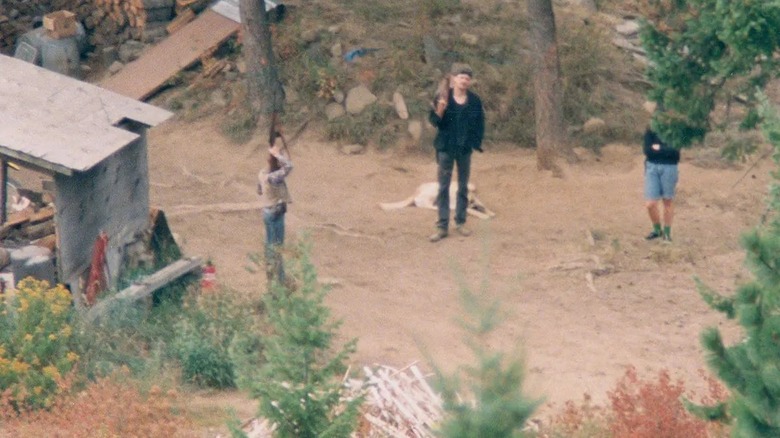What Was Sara Weaver's Life Like After The Ruby Ridge Standoff?
We may receive a commission on purchases made from links.
The 1990s saw one of the worst domestic terrorist attacks on American soil up until that point and since: the April 19, 1995 bombing of the Alfred P. Murrah Federal Building in Oklahoma City, Oklahoma. The attack claimed 168 lives and caused several hundred injuries (according to the FBI). The bomber, a radicalized right-wing extremist named Timothy McVeigh, cited two specific reasons for his vendetta against the government of the United States (via Columbia University): the government's raid on the Branch Davidian Compound in Waco, Texas, and an attempt in Idaho to arrest a fugitive that turned into a lengthy siege in which two members of the wanted man's family — including a juvenile — and his dog were killed. Today, the event is known as the Ruby Ridge standoff, or colloquially, just Ruby Ridge.
During the siege, 16-year-old Sara Weaver stood within feet of her mother as she was struck by a sniper's bullet, according to NBC News. That was nearly 30 years ago, and Sara, like all people with post-traumatic stress disorder (PTSD), dealt with the after-effects of living through such violence. As of 2018, however, she had made peace with what happened to various members of her family.
If you or someone you know needs help with mental health, please contact the Crisis Text Line by texting HOME to 741741, call the National Alliance on Mental Illness helpline at 1-800-950-NAMI (6264), or visit the National Institute of Mental Health website.
The Weaver Family
Randy Weaver was, for a time anyway, an ordinary man. He was born in Iowa, the son of a grain salesman. By the 1980s, however, he was on a different path. Believing that the world was "corrupt" (via The Washington Post), he moved his family to a remote section of Idaho and began trying to live a life of self-sufficiency off the grid (via the Justice Department). Also at around this time, he began exhibiting behavior that would suggest he'd been radicalized; specifically, a neighbor alleged that Weaver had threatened to kill then-President Ronald Reagan, then-Pope John Paul II, and then-Governor of Idaho John. V. Evans.
Being an anti-government radical is not, on its own, a criminal offense. But when Weaver was accused of selling illegal sawed-off shotguns to an informant, Weaver's relationship with the government soured further. According to The Washington Post, the Bureau of Alcohol, Tobacco and Firearms tried to convince Weaver to work with them as an informant in exchange for the gun charges being dropped. He refused, and a grand jury indicted him on gun charges. He failed to show up in court, and he became a wanted man.
The Ruby Ridge Siege
According to the book "Christian Identity: The Aryan American Bloodline Religion," in June 1990, an arrest warrant was sworn against Randy Weaver that alleged he had been growing marijuana, been involved in a bank robbery, had explosive traps and guns mounted on tripods around his property, and had threatened to shoot officers, among other allegations. The book claims that none of those allegations were true.
On August 21, 1992, a team of U.S. Marshals turned up near Weaver's compound, scouting the area for locations to mount an arrest mission (via NBC News). However, the team spotted Samuel — Weaver's 14-year-old son — and Weaver's friend Kevin Harris. A gunfight broke out, and soon Samuel and a Marshal were killed.
The next day, Randy Weaver was shot by a sniper but did not suffer life-threatening wounds. Weaver's wife, Vicki Weaver, as well as his teenage daughter, Sara, retreated into a cabin. A sniper shot Vicki in the head, killing her instantly, as she held her 10-month-old baby (who was not injured), according to People.
Sara Weaver would spend the next 10 days in the same cabin as the body of her mother and spent those days procuring food and water for the other people holed up on the family property, including her infant sibling. The family surrendered 10 days later.
The Aftermath
The siege of Ruby Ridge began as an attempt to arrest a man on non-violent gun charges (and informed by possibly-trumped-up charges in an arrest warrant) and lasted 10 days. It claimed the lives of two innocent family members of the wanted man – a mother and her teenage son — plus the life of the family dog and a law enforcement officer. At the end of the day, however, it was all for naught, as Randy Weaver and his alleged co-conspirator, Kevin Harris, were acquitted of all charges (via NBC News). It would take years of maneuvering through the courts, but eventually, the surviving members of the Weaver family were all awarded monetary settlements.
In a broader sense, however, the Ruby Ridge siege became a rallying cry for Americans concerned that the government was becoming their enemy. "Ruby Ridge was the opening shot of a new era of anti-government hatred not seen since the Civil War," said Mark Potok of the Southern Poverty Law Center (per NBC News). Oklahoma City bomber Timothy McVeigh cited Ruby Ridge, as did later would-be domestic terrorists. "In death, Weaver and Ruby Ridge are still inspiring some of the most dangerous political currents in America," noted the Southern Poverty Law Center in May 2022, after Randy Weaver died.
Decades Of Hate
After the siege, 16-year-old Sara Weaver and her surviving family members went to Iowa to live Randy Weaver's mother's family, according to NBC News. As mentioned previously, she, her father, and siblings all sued, and each won judgments; Sara and her siblings were each awarded $1 million.
For the next couple of decades, Sara experienced depression and PTSD. She also harbored resentment against the government. "After losing mom and Sam, I almost felt guilty even thinking about being happy after they were gone. But that's a lie. Your family members don't want you to grieve them. They want you to move on," she told NBC News.
During her time in Iowa, Sara continued with her parents' religious ideology (via People). She took down photos, believing them to be idols, and even advocated for having the family's TV thrown away. However, by her senior year in high school, she'd begun to mellow — somewhat — and took to poetry to channel her anger. But it wasn't until the early 2000s that she finally began to make peace with her place in the history of domestic terrorism in the U.S.
If you or someone you know needs help with mental health, please contact the Crisis Text Line by texting HOME to 741741, call the National Alliance on Mental Illness helpline at 1-800-950-NAMI (6264), or visit the National Institute of Mental Health website.
Finding Peace and God
Sara Weaver had always been a religious person, raised in her parents' faith that compelled them to withdraw from the modern world in the first place. However, prior to 2003, Sara's version of Christianity had been one in which an angry and vengeful god demands obedience at all costs; "I had a fear-based relationship with God," she said, via NBC News. But in 2003, a friend of hers introduced her God in a different way: the loving and forgiving version. "I decided I was broken and needed to be fixed," she said, adding that, though she's not interested in meeting them, she has forgiven the federal agents responsible for her mother's and brother's deaths.
Sara has written two books. The first, published with her father in 1998, is entitled "The Federal Siege at Ruby Ridge," and the second, "From Ruby Ridge to Freedom: The Sara Weaver Story," published in 2012. The latter book focuses not on the events of the siege but her personal journey since then.
As of 2012, Sara had been divorced and then remarried and was operating a horse-breeding farm in Montana along with her second husband. In May 2022, as the Southern Poverty Law Center reported, Sara announced via her own social media channels that her father, the man at the center of it all, had died.





